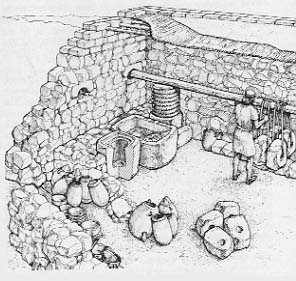Image Details

Tel Miqne/Ekron Excavation Project, Drawing: E. Cohen
In the second step of the oil-rendering process, the pulp was placed in woven baskets that were stacked on smaller vats, an both sides of the large basin, and topped with a stone. Pressure applied by a long wooden beam, weighted down by stones an one end, squeezed the remaining oil out of the pulp. This arrangement is illustrated only on the right side of the central vat, but an identical installation existed of the left side, where this reconstruction shows just a cutaway view of the left vat. At lower left the reconstruction shows some of the hundreds of vessels found in the room. Destroyed by the Babylonians in 603 B.C., Ekron was then for the most part abandoned, preserving its buried artifacts in place for discovery by 20th-century archaeologists.
